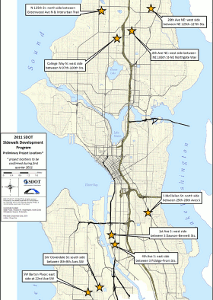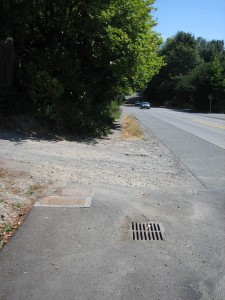This is a guest post by Marjorie, a Seattle bus rider and pedestrian.
I’m living with my elderly mother in the house my parents bought in the 50s, and when the sidewalks were installed in the 60s my parents were assessed on their property taxes for 10 years to pay for these.
If the city is now giving people sidewalks without the property owners having to pay, then the city should reimburse (with interest) those who had to pay for their own sidewalks. I might make an exception for arterials. Arterials should always have sidewalks, but ironically many Seattle arterials don’t have these.
And property owners need to be reminded that they are responsible for maintaining their sidewalks. I spend many, many hours every year digging up the weeds that grow through the cracks. Otherwise the sidewalks will buckle and break and become unsafe for pedestrians.
How many people holler for sidewalks but then neglect them once installed? I have little patience with property owners who don’t accept the responsibility that goes with having sidewalks:
- Don’t park cars across curb cuts in sidewalks.
- Sweep or rake leaves – don’t let them pile up on sidewalks.
- Make sure tree branches are at least 8 feet off the ground over sidewalks.
- Prune back any shrubs growing over sidewalks.
- Make sure that tree branches don’t block street lights from illuminating sidewalks after dark.
- Don’t use parking strips (a.k.a. planting strips) for growing anything over about a foot high. It can obstruct the view of drivers and could lead to tragic accidents. Grow your veggies and flowers in your yard. Public safety should not be compromised.
And the government should not allow developers to block sidewalks for construction projects. This is unfair to pedestrians and can lead to bus riders missing bus connections at transfer points.







